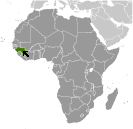World Atlas: Guinea. On this page you can see the map, country flag and many detailed information about the people, history and economy of Guinea.

Here you can find online selected information about the geography, inhabitants, government, economy and history of Guinea. Included are selected statistics, an overview map and the detailed map of Guinea. But let's start with the flag of Guinea here:
Guinea - Overview:
What you should know about Guinea? Let's start with this: Guinea is at a turning point after decades of authoritarian rule since gaining its independence from France in 1958. Sekou Toure ruled the country as president from independence to his death in 1984. Lansana Conte came to power in 1984 when the military seized the government after Toure's death. Gen. Conte organized and won presidential elections in 1993, 1998, and 2003, though all the polls were rigged. Upon Conte's death in December 2008, Capt. Moussa Dadis Camara led a military coup, seizing power and suspending the constitution. His unwillingness to yield to domestic and international pressure to step down led to heightened political tensions that peaked in September 2009 when presidential guards opened fire on an opposition rally killing more than 150 people. In early December 2009, Camara was wounded in an assassination attempt and exiled to Burkina Faso. A transitional government led by Gen. Sekouba Konate paved the way for Guinea's transition to a fledgling democracy. The country held its first free and competitive democratic presidential and legislative elections in 2010 and 2013 respectively, and in October 2015 held a second consecutive presidential election. Alpha Conde was reelected to a second five-year term as president in 2015, and the National Assembly was seated in January 2014. Conde's first cabinet is the first all-civilian government in Guinea. The country held a successful political dialogue in August and September 2016 that brought together the government and opposition to address long-standing tensions.
Geography of Guinea
 Where on the globe is Guinea? The location of this country is Western Africa, bordering the North Atlantic Ocean, between Guinea-Bissau and Sierra Leone. Total area of Guinea is 245,857 sq km, of which 245,717 sq km is land. So this is quite a large country. How could we describe the terrain of the country? This way: generally flat coastal plain, hilly to mountainous interio. The lowest point of Guinea is Atlantic Ocean 0 m, the highest point Mont Nimba 1,752 m. And the climate is generally hot and humid; monsoonal-type rainy season (June to November) with southwesterly winds; dry season (December to May) with northeasterly harmattan winds.
Where on the globe is Guinea? The location of this country is Western Africa, bordering the North Atlantic Ocean, between Guinea-Bissau and Sierra Leone. Total area of Guinea is 245,857 sq km, of which 245,717 sq km is land. So this is quite a large country. How could we describe the terrain of the country? This way: generally flat coastal plain, hilly to mountainous interio. The lowest point of Guinea is Atlantic Ocean 0 m, the highest point Mont Nimba 1,752 m. And the climate is generally hot and humid; monsoonal-type rainy season (June to November) with southwesterly winds; dry season (December to May) with northeasterly harmattan winds.
Inhabitants of Guinea
Let's take a look how many people live in Guinea. The number is: 12,413,867 (July 2017 est.). So this is not very populous country. Who lives here? Fulani (Peul) 32.1%, Malinke 29.8%, Susu 19.8%, Guerze 6.2%, Kissi 4.7%, Toma 2.8%, other/no answer 4.6% (2012 est.). What are the languages in Guinea? French (official). And the religions: Muslim 86.2%, Christian 9.7%, animist/other/none 4.1% (2012 est.). How old are the people in average? 18.9 years. We have to add that this number is the median - so one half of the people is older than this, one half is younger. And what is their life expectancy (at birth)? This: 61 years. Where the people live in Guinea? Here: areas of highest density are in the west and south; interior is sparsely populated. The major urban areas of Guinea are: Conakry (capital) 1.936 million (2015).
Government and Economy of Guinea
The capital of Guinea is Conakry and the government type presidential republic. Let's take a look at the administrative divisions - 7 regions administrative and 1 gouvenorat; Boke, Conakry, Faranah, Kankan, Kindia, Labe, Mamou, N'Zerekore. Regarding the economy of Guinea, important industrial products are bauxite, gold, diamonds, iron ore; light manufacturing, agricultural processing. Important agricultural products are rice, coffee, pineapples, mangoes, palm kernels, cocoa, cassava (manioc, tapioca), bananas, potatoes, sweet potatoes; cattle, sheep, goats; timbe. The most important export commodities are bauxite, gold, diamonds, coffee, fish, agricultural products and the most important export partners are China 24.6%, Ghana 17.9%, Switzerland 10.1%, UAE 7.7%, France 5.2%, Spain 4.3%, India 4.1% (2016). The most important import commodities are petroleum products, metals, machinery, transport equipment, textiles, grain and other foodstuffs and the most important import partners are Netherlands 14.6%, China 13.5%, India 12.4%, Belgium 8.6%, France 6.9%, UAE 5.4%, Singapore 4.9% (2016). How rich is Guinea and how rich are people in this country? The most important number here is GDP per capita (PPP): $2,000 (2017 est.). This is a very low number. Let's add that this means Gross Domestic Product per person, which is recalculated with respect to the relative cost of local goods and services. And one more important number - population below poverty line: 47% (2006 est.).